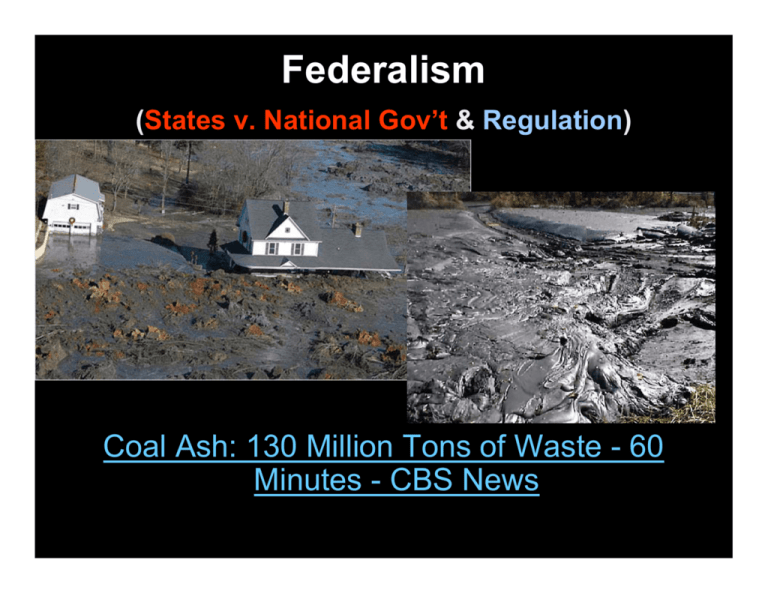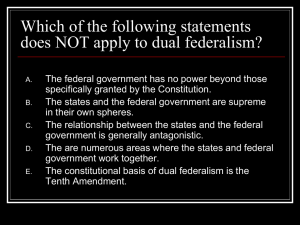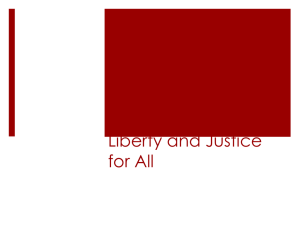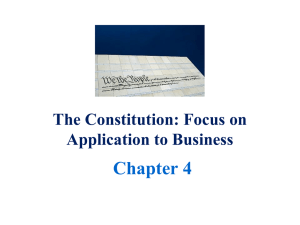Federalism
advertisement

Federalism (States v. National Gov’t & Regulation) Coal Ash: 130 Million Tons of Waste - 60 Minutes - CBS News Federalism and the Supreme Court McCulloch v. Maryland (1819) Stretching federal power • John Marshall, the Federalist Chief Justice of the Supreme Court, wrote the opinion in McCulloch v. Maryland. • He addressed two questions: "Does Congress have the authority to charter the bank?" and "Does the state of Maryland have the power to tax the bank?" • In a positive answer to the first question, Marshall argued that the necessary and proper clause of the Constitution, also known as the "elastic clause," implied that Congress could charter a national bank in the exercise of its explicit power to regulate interstate commerce and coin and regulate money. • In response to the second question, Marshall affirmed that "the power to tax is the power to destroy," and that allowing the state to tax the national bank would therefore violate the supremacy clause (Article VI) of the Constitution. By ruling against the state of Maryland, the Marshall Court greatly expanded the power of the national government to implement Hamilton's economic vision. Gibbons v. Ogden (1824) Getting steamed up over commerce... • • • • This case disputed who had exclusive rights to control ferry operations on the Hudson River between NY and NJ. The state of New York had granted an exclusive license to Aaron Ogden to operate a ferry on the Hudson. However, Congress had licensed Thomas Gibbons to operate on the Hudson under a 1793 act dealing with vessels "employed in the coasting trade and fisheries." The conflict between the two steamboat operators -- one licensed by New York and the other by Congress -- ended up before the Supreme Court. Marshall declared that the ferry was engaged in interstate commerce, and it was therefore under the jurisdiction of the national government. The scope of what constitutes interstate commerce was broadly defined, and Marshall asserted that Congress had full power to regulate any activity that fell within this definition. At the same time, Marshall concluded that matters of "purely internal" commerce were the exclusive province of the states- thus introducing the concept of dual federalism. Barron v. Baltimore (1833) Enforcing dual federalism... • Marshall wrote that the Fifth Amendment of the Bill of Rights protected individuals against actions only by the national government, not by the state governments. • If Barron was entitled to a remedy, it must be one provided by the laws of the state of Maryland or the city of Baltimore. The effect of Marshall's ruling was to reinforce the system known as dual federalism, which allocated separate and distinct spheres of power to the national government and the states. Scott v. Sandford (1857) The Supreme Court lights the fuse... • The Supreme Court declared that slaves were property, not citizens, and thus did not possess any constitutional rights. • Furthermore, in stating that Congress had no authority to outlaw slavery in the federal territories, the Court ruled the Missouri Compromise itself was unconstitutional, thereby limiting the power of the national government over the states. The 14th Amendment Three Key Clauses: “No State shall. . .” 1.Privileges and Immunities Clause 2.The Due Process Clause (life liberty and property may not be deprived without…) 3.Equal Protection Clause. Slaughterhouse Cases (1873) Of privileges and immunities... • By a narrow 5-4 margin, the Court ruled that the Louisiana statute did not violate the privileges and immunities clause of the 14th Amendment. In the majority's view, this clause only protected rights granted to citizens by the United States, and not rights that were the responsibility of the individual states. • If there was a right to engage in a lawful occupation, argued the majority, then this right was one of state citizenship. Since Louisiana did not grant this right, and since the state had the responsibility for regulating public health and safety, the slaughterhouse monopoly was not unconstitutional. The Court's decision limited the application of the Fourteenth Amendment to the states, and undermined the effort to restore the power of the national government in the wake of the Civil War. • US v. Cruickshank (1875)- 15th Amendment does not apply to an individual’s action, only a state’s. Lochner v. New York (1905) Liberty of contract vs. the police power Liberty of contract vs. the police power • By declaring that the state of New York had no authority to set a maximum number of working hours, the Court restricted New York's ability to regulate business activity in the state. This ability had generally been considered part of the state's "police powers" exercised under the "reserve clause" of the Tenth Amendment. • Although the state's loss was not the national government's gain, the Court's decision appeared to endorse a free-market capitalist ideology hostile to economic regulation. 1937: The Switch in Time That Saved Nine Cooperative Federalism • In 1936, the Supreme Court invalidated two important pieces of New Deal legislation (US v. Schechter 1935), the Agricultural Adjustment Act and the National Recovery Act, on the grounds that they were beyond the scope of the national government's authority- specifically the President did not have the authority to legislate or regulate interstate commerce. • The Supreme Court began reversing itself in 1937 on many New Deal-related cases, approving much of what it had previously struck down. The sudden turnabout has been called "the switch in time that saved nine" • The 1937 decisions marked a clear shift in favor of the federal government's authority to regulate economic matters, and introduced the era of cooperative federalism. For more than four decades, the national government worked closely with state and local governments to administer a host of programs designed to combat poverty and promote economic development. During this entire period, the Supreme Court permitted Congress considerable latitude, under the commerce clause, to expand the power of the federal government. US v. Darby (1941) Tenth Amendment, Smenth Amendment. . • The Supreme Court called the 10th Amendment a "constitutional truism." Its just a statement that the states have independent powers of their own- not a declaration that state powers are in any way superior to those of the national government. • US v. Darby (1941) was a case in which the United States Supreme Court upheld the Fair Labor Standards Act, holding that the U.S. Congress had the power under the Commerce Clause to regulate employment conditions. The unanimous decision of the Court in this case overturned several longstanding precedents, notably Hammer v. Dagenhart, (1918). Brown v. Board of Ed. (1954) The Federal government helps end racial segregation . . • Brown v. Board of Education of Topeka outlawed racial segregation of public education facilities. Ruling so on the grounds that the doctrine of "separate but equal" public education could never truly provide black Americans with facilities of the same standards available to white Americans (14th Amendment). • Brown did not, however, result in the immediate desegregation of America's public schools, nor did it mandate desegregation of public accommodations, such as restaurants or bathrooms, that were owned by private parties, which would not be accomplished until the passage of Title II of the Civil Rights Act of 1964. Heart of Atlanta Motel v. US (1964) Another blow to state discrimination . . . Heart of Atlanta Motel Inc. v. United States (1964) • The Court held that Congress acted well within its jurisdiction of the Interstate Commerce clause in passing the Civil Rights Act of 1964. • Having observed that 75% of the Heart of Atlanta Motel's clientele came from out-of-state, and that it was strategically located near both Interstates 75 and 85, the Court found that the business clearly affected interstate commerce. It therefore required the Heart of Atlanta Motel to serve clientele of all races. Thus, De Jure segregation was over. . . sort of. National League of Cities v. Usery (1976) The Tenth Amendment makes a comeback. . . The Birth of New Federalism The 10th amendment means that Congress cannot exercise its power so as to impair on the State's integrity or their ability to function effectively in a federal system. Congress may have the authority to regulate individual businesses under the Commerce Clause, but in this case they are regulating not just individuals, but the "States as States." To allow the federal government to regulate the states, the majority reasoned, would be to negate the federal system of government embodied by the Constitution. The Court also mentioned that the FLSA's requirements would result in a substantial cost burden. Garcia v. San Antonio Metro (1985) The Tenth Amendment is down for the count- again. . Once again the Tenth Amendment is a truism. . . • Garcia v. San Antonio Metropolitan Transit Authority (1985), holds that the Congress has the power under the Commerce Clause of the Constitution to extend the Fair Labor Standards Act, which requires that employers provide minimum wage and overtime pay to their employees, to state and local governments. US v. Darby (1941) • The decision overruled National League of Cities v. Usery (1976). US v. Lopez (1995) Reeling in the commerce clause... The Theory of Devolution. . . • In the Lopez case, the Supreme Court shocked observers by ruling that in passing the Gun Free School Zones Act Congress had exceeded its authority under the commerce clause. By a margin of 5-4, the Court ruled that local gun control was a state and local matter, beyond the power of the federal government to regulate. The decision in this case represented a major victory for advocates of greater state autonomy and “New Federalism.” US v. Morrison (2000) Rehnquist says: Violence Against Women Act - Smilence Against Women Act! Women need the VAWA, “like a fish needs a bicycle.” – William H. Rehnquist In the case of U.S. v. Morrison (2000), the Court struck down key provisions of the Violence Against Women Act (1994), which provided victims of "gender-motivated" violence with the opportunity to sue their attackers for damages in federal court. Although most of the states supported the law, the Court applied the Lopez precedent and concluded that Congress had exceeded its commerce clause authority in enacting this legislation. Moreover, the majority declared that the Violence Against Women Act was also not an acceptable exercise of congressional power to guarantee equal protection under the Fourteenth Amendment. Listen to the announcement of the Court's opinion in Morrison at: http://www.oyez.org/oyez/resource/case/1261/audioresources NPR: The Long, Colorful History of the Mann Act Rehnquist’s New Federalism PRO Supporters of the new judicial federalism contend that the Supreme Court has finally delivered a well-deserved slap on the wrist to Congress, putting an end to the decades-long expansion of national power at the expense of the states. CON Critics of the Rehnquist Court argue that decisions such as Morrison pose a serious threat to vital federal civil rights and anti-discrimination legislation. Consumer Issues Top Supreme Court's Docket : NPR Summary: • For much of the 19th century, the Supreme Court allowed the federal government to exercise control over a limited set of national economic issues, while state governments were free to set their own policies on racial matters. • In the twentieth century, especially after 1937, the Supreme Court extended the power of Congress to regulate economic activity and upheld the expansion of federal power to guarantee civil rights for all Americans. • In recent years, however, there has been a broad movement to return more power to the states, with support from a narrow majority of the Supreme Court.






